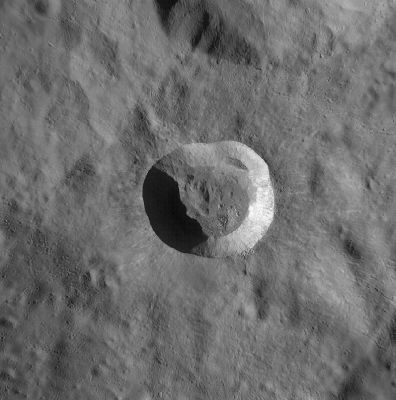Giordano Bruno
Contents
[hide]Giordano Bruno
|
Lat: 35.92°N, Long: 102.74°E, Diam: 22.13 km, Depth: km, Rükl: (farside), Copernican | |
Right: Clementine
Images
LPOD Photo Gallery Lunar Orbiter Images Apollo Images Kaguya HDTV
- Searching Apollo photographs of the Giordano Bruno area is a wonderful pastime. Apollo 16's color-Hasselblad AS16-121-19445 shows the bright rays of Giordano Bruno (and the crater itself) at the lower left part of the frame. See also AS16-121-19434, on which it is captured near the frame's centre.
- AS08-12-2209 is one of Apollo 8's photographs of Giordano Bruno.
- Research: Danny Caes
Maps
(LAC zone 29C3) USGS Digital Atlas PDF
Description
A 22 km wide very fresh impact crater with rays, impact melt and spectral evidence (OMAT) for a very young age. Originally crater counts from Kaguya images suggested a formation age of about 4 million years, but 20 times higher resolution LRO images showed that many of the craters are likely to be secondaries and thus the age is much younger, consistent with observations of an explosion on that part of the Moon on June 18, 1178 (Hartung, 1976).
Wikipedia
Additional Information
- IAU page: Giordano Bruno
- No Tycho-like dark ring of impact melt despite young age. Too small to have enough melt to make ring? [Kirata et al LPSC 30: 1350]
- Included in ALPO list of bright ray craters
A lunar vortex and a geometric boulder
- A peculiar vortex-shaped (or swirl-shaped) arrangement of dark arcs and boulders is noticeable in a flat "lake" at the western part of Giordano Bruno's floor, attached to its western inner slopes. Independently discovered by Danny Caes. Is this a unique formation on the moon's surface? See the LRO's ACT-REACT Quick Map. Warning: to get this vortex in the center of your screen, write 102.62 in the oblong LON quadrangle, and 35.98 in the oblong LAT quadrangle. Choose number 2 in the small M/PIX quadrangle, and hit the button RECENTER. - DannyCaes Jun 12, 2011
- See also Giordano Bruno Whorl.
- A remarkable 100 meter diameter boulder with corner of 90 degrees at the shadowed northern part of it is detectable at LON: 102.696, LAT: 36.016, M/PIX: 1. - DannyCaes Jun 12, 2011
Nomenclature
- Giordano Bruno (1548 – February 17, 1600) was an Italian philosopher, priest, cosmologist, and occultist. Bruno is known for his system of mnemonics based upon organized knowledge and as an early proponent of the idea of an infinite and homogeneous universe. Burned at the stake as a heretic by the Roman Inquisition, Bruno is often seen as the first "martyr for science."
- Discovered in Lunik 3 imaging of farside and named in Atlas of the Far Side of the Moon and approved by the IAU in 1961 (Whitaker, p 232).
LROC Articles
Because Giordano Bruno is a favourite subject of many selenologists, many articles about that ray crater appeared on the LROC site.
Articles (Posts) in which Giordano Bruno is mentioned:
57. Impact Melt Flows on Giordano Bruno
109. Stream of Secondary Craters (from Giordano Bruno?).
267. Delicate Patterns in Giordano Bruno's Ejecta
297. Fragmented Impact Melt (the wonderful Craquelé effect at Giordano Bruno).
418. Outside of Giordano Bruno
526. In the Wake of Giordano Bruno
540. Sunset over Giordano Bruno
598. Very Oblique View of Giordano Bruno
623. Giordano Bruno, the big picture
694. Giordano Bruno Whorl (one of the most unique features on the whole of the moon's surface!).
803. Frozen Motion (Harkhebi J, north-northeast of Giordano Bruno).
843. NAC Anaglyph: Giordano Bruno ejecta (1).
861. NAC Anaglyph: Giordano Bruno ejecta (2).
LPOD Articles
- A Burning Issue
- Formed 1000 yrs ago
- Rays
- The Youngest Large Crater on the Moon?
- 833 years plus 2 days
Bibliography
- Hartung, J. B. (1976) Was the formation of a 20-km-diameter impact crater on the moon observed on June 18, 1178. Meteoritics, vol. 11, pp. 187-194.
- Calame, O.; Mulholland, J. D. 1978. Lunar crater Giordano Bruno - A.D. 1178 impact observations consistent with laser ranging results. Science, vol. 199, pp. 875-877.
- Sagan, C. (1980). COSMOS.
- Mims, S. S.; James, R. W. 1982. Meteors from Giordano Bruno Ejecta. LUNAR AND PLANETARY SCIENCE XIII, pp. 520-521. Abstract
- Hartung, J. B. (1993) Giordano Bruno, the June 1975 meteoroid stream, Encke, and other Taurid Complex objects. Icarus 104, 280-290.
- Withers, P. (2001) Meteor Storm Evidence Against the Recent Formation of Giordano Bruno. Lunar & Planetary Science XXXII, #1007.
- J. B. Plescia, M. S. Robinson, and D. A. Paige (2010). GIORDANO BRUNO: THE YOUNG AND THE RESTLESS. 41st Lunar and Planetary Science Conference Abstract #2038.
Named Featues -- Prev: Gioja -- Next: Glaisher

